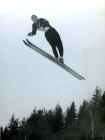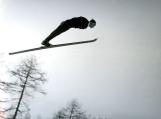1
In the early years, there was no coaching and no training, people simply watched, experimented, learned, watched some more and kept trying new techniques. Because of this, there was no "one" style but many styles. All the jumping skis had grooves in the bottom as that helped them to track better, but that is where the similarities ended. As for clothing and jumping styles, these differed with each individual.In general, clothing was comfortable and hopefully somewhat "damp-proof." Most of the men jumped in wool sweaters and wool britches, wool, knee-high socks and sturdy lace boots. Isabel Coursier jumped in the same though she would wear a wool jacket up top.
The early years saw jumpers with their arms out to the sides, sometimes straight out, sometimes overhead, sometimes slightly forward. Each jumper had their own technique for what worked for them. The better jumpers leaned into the hill, hips forward in an unbroken line from the ski. This took a lot of courage. Less experienced jumpers might have a bend at the hip, which was a little less terrifying.
2
Ski jumper on Mt. Revelstoke1925
Revelstoke, British Columbia
 Credits:
Credits:Revelstoke Museum and Archives
3
Ernie Field, Class "B" World Champion1925
Revelstoke, British Columbia
 Credits:
Credits:Revelstoke Museum and Archives
4
There were small jumps built all over town where boys practiced. Often it was simply a matter of piling up snow and having a slight incline on which to gather some speed for the jump. Girls jumped with the boys at competitions off the "C", "D", and "E" jumps.Ivind Nilsen was known for his perfect form. He was compared to a "bird in flight" and one could tell from a long distance if Ivind was jumping.
5
Ivind Nilsen jumping on Mt. Revelstokec. 1920
Revelstoke, British Columbia
 Credits:
Credits:Revelstoke Museum and Archives
6
As jumpers progressed, they became more aerodynamic and experimented with different arm positions. Petter Hugsted was the Olympic champion from Norway in 1948.7
Petter Hugsted jumping on the Nels Nelsen Hill1949
Revelstoke, British Columbia
 Credits:
Credits:Revelstoke Museum and Archives

